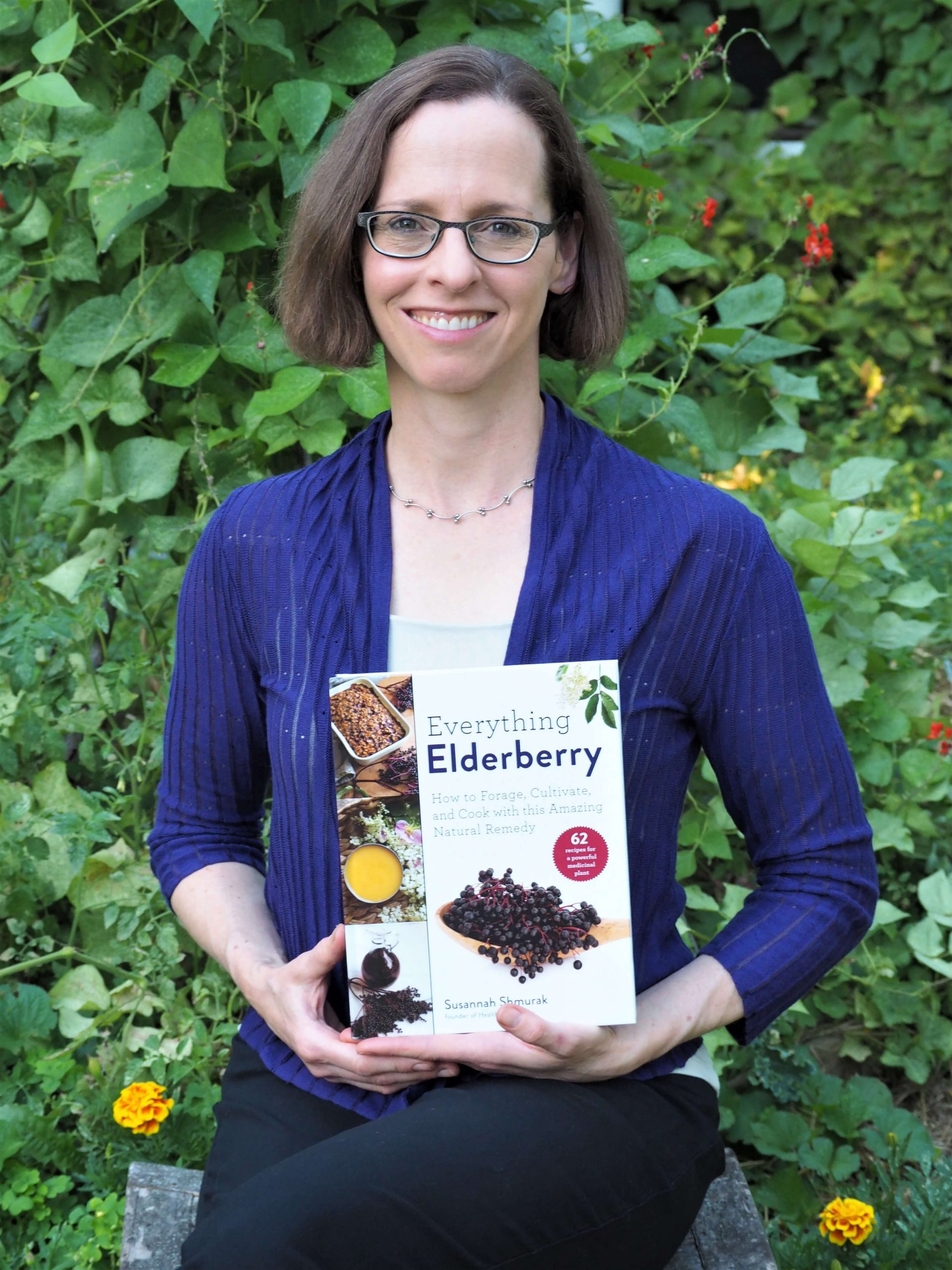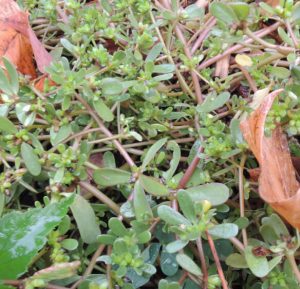Last Updated on May 30, 2025
Did you know many common weeds are edible — AND delicious? Not to mention incredibly nutritious. Yes, there are numerous weeds you can eat!
It’s that time of year when weeds are evvvvverywhere, and homeowners look at their gardens and sigh.
Not me! I give a little cheer and get to harvesting all that delicious, healthy, free food! Ingredients for salads, smoothies, and pizza toppings abound in our yard long before anything I planted is ready to harvest.
Is your yard overrun by dandelions? Purslane? Don’t despair. It turns out these are weeds you can eat, which are not only tasty but brimming with nutrients.
Maybe in time you’ll stop seeing them as weeds, but as valuable and nutritious additions to your edible landscape!
Always consult a good field guide for foragers or enlist a local expert so you know what you’re collecting. While most of these plants are easy to identify, others have non-edible or poisonous look alikes.
Here are my favorite foraging books.
If you’d like to become more expert in the art of foraging, the Herbal Academy has an online foraging course that teaches plant identification and ethical wildcrafting practices.
Yup, there are LOADS of weeds you can eat! Here are some great places to start for the novice home forager.
Top Weeds You Can Eat
1. Dandelions
Dandelions top most foragers’ lists of nutritious and delicious “weeds.” Dandelion greens work as pizza toppings, in salads, and in stir-fries. I’ve collected more than 35 ways to use these abundant gifts from nature; check out this info on how to eat dandelions.
Here are just a few inventive uses for this easy-to-find foraged food:
♦ Here’s a tempting recipe for dandelion pesto
♦ The Splendid Table has a recipe for dandelion flower cookies
♦ Try making healthy herbal teas from the flowers, leaves, and roots. Here’s how to make dandelion tea.
♦ Ashley at Practical Self Reliance turns makes a yummy-looking dandelion and honey ice cream!
♦ Sarah at Nature’s Nurture has a wonderful collection of ideas for using dandelions in an impressive array of recipes. If you’re feeling really ambitious, you could roast the roots for a coffee-like drink.
Though usually seen as exceptionally pesky weeds, dandelions are versatile and very nutritious. The flowers are also important early food for bees, so if you want to help out our pollinators, try to leave some dandelion flowers in your yard in early spring, when there’s not much else for them to eat.
2. Wood Sorrel
Wood sorrel, more commonly known as sourgrass, is one of the next edible weeds to appear. It has delicate heart-shaped leaves that taste vaguely lemony. Great in salads, or to nibble on while you’re working in the garden.
Kids love them, and my 5-year-old will happily pick herself a snack while she’s keeping me company. Sprinkle them on your salad or let your toddler nibble them while you dig up dandelions. Here’s what to know about identifying and using wood sorrel.
Related: How to Identify Elderberry Plants for Delicious Foraged Food
3. Wild Violets
I’ve always been a big fan of violets, which spread nicely to shady areas and make a great groundcover. After all my failed attempts at vegetable gardening in the too-shady front yard, they have been a welcome takeover.
Imagine my delight when I discovered you can eat them as well! They also have some appealing medicinal uses, including as a popular herbal remedy for coughs. Find out more about using wild violets.
If you have other purplish blooms and you’re wondering what they are, check out our guide to weeds with purple flowers.
4. Purslane
I’m eagerly awaiting the reappearance of my purslane, a rockstar of the weed world. High in vitamin E and other nutrients, it’s also one of the best plant-based sorurces of omega-3s. Check out my recipe for a delicious and healthy anti inflammatory smoothie.
Apparently purslane is also good in stirfries, though I’ve never had enough left over from smoothies to try. Read more about purslane and recipes for using it here.
5. Lambs quarters
Lambs quarters, a relative of amaranth and quinoa, is another nutritious green for spring salads and cooking. Also known as wild spinach, it’s a mild-tasting and easy-to-find plant that can sub for spinach and works in numerous lambs quarter recipes.
Other Common Weeds You Can Eat
6. Mallow
Common mallow (Malva neglecta) is an often-overlooked but valuable potherb that can also be used medicinally. It’s one of many weeds with pink flowers you might find in your garden.
7. Nettles
Nettle is not only a super-nutritious green, it makes a soothing tea thought to boost your immune system and alleviate allergies. Nettle’s cousin Canadian wood nettle can be used in similar ways.
8. Virginia Waterleaf
Virginia waterleaf is one of the earliest (though not the tastiest) edible weeds you’ll find growing abundantly before other greens show up.
9. Chickweed
Chickweed is another nutritious option, as Michelle from Seeking Joyful Simplicity explains in her post on chickweed pesto. Here’s more on chickweed identification.
Some additional edible weeds to explore:
Cleavers is a popular spring tonic, great for moving sluggish lymph, treating skin issues, and more. Here’s more about using cleavers plant.
Plantain, one of several “weeds” and weed-like plants that are excellent additions to your home remedy arsenal. Plantain is great for skin irritation and is a useful remedy for bug bites and an effective natural cough remedy as well.
Japanese knotweed is another invasive worth eating, according to Ashley from Practical Self Reliance.
Even creeping charlie can be cooked like spinach or brewed into a healthful tea.
Plentiful velvetleaf has edible leaves and seeds. Here’s what to know about using velvet leaf plant.
Though it doesn’t grow in my region, kudzu (the weed that ate the south) is also edible. If you’ve tried it, leave a comment and let me know how it is!
These weeds you can eat are everywhere. Go harvest yourself some free wild vegetables you didn’t even realize you were growing in your front yard vegetable garden!
Other foraged foods you can find growing on trees in your neighborhood:
- Mulberries
- Spruce tips (try in these spruce tip recipes; you can also use spruce needles for spruce tea)
- Pine (much of the pine is edible, but the needles are especially easy to brew into a pine needle tea)
- Juneberries
These are just a small selection of some of the edible weeds you might find in a yard near you. If you want to explore more, my go-to resource for foraged edibles is Wildman Steve Brill. Check out his comprehensive list of edible wild plants you might find in your yard (as well as his amazing recipes using wild foods. Cattail soup anyone?).
I also love the information at Eat the Weeds and Edible Wild Food.
Foraging your own food is just one way green living can save you money. Here’s how we’ve saved thousands of dollars with home solar power and energy conservation. Here are lots more ways going green saves money.
Pin to save these fantastic weeds you can eat for later!
Follow my foraging Pinterest board for lots more tips on finding free wild foods!

Susannah is a proud garden geek and energy nerd who loves healthy food and natural remedies. Her work has appeared in Mother Earth Living, Ensia, Northern Gardener, Sierra, and on numerous websites. Her first book, Everything Elderberry, released in September 2020 and has been a #1 new release in holistic medicine, naturopathy, herb gardening, and other categories. Find out more and grab your copy here.




 Hi, I'm Susannah, a garden geek, energy nerd, and fan of healthy food and natural remedies. Need some simple, practical solutions for living healthier and greener? You've come to the right place! More about me and my green projects
Hi, I'm Susannah, a garden geek, energy nerd, and fan of healthy food and natural remedies. Need some simple, practical solutions for living healthier and greener? You've come to the right place! More about me and my green projects